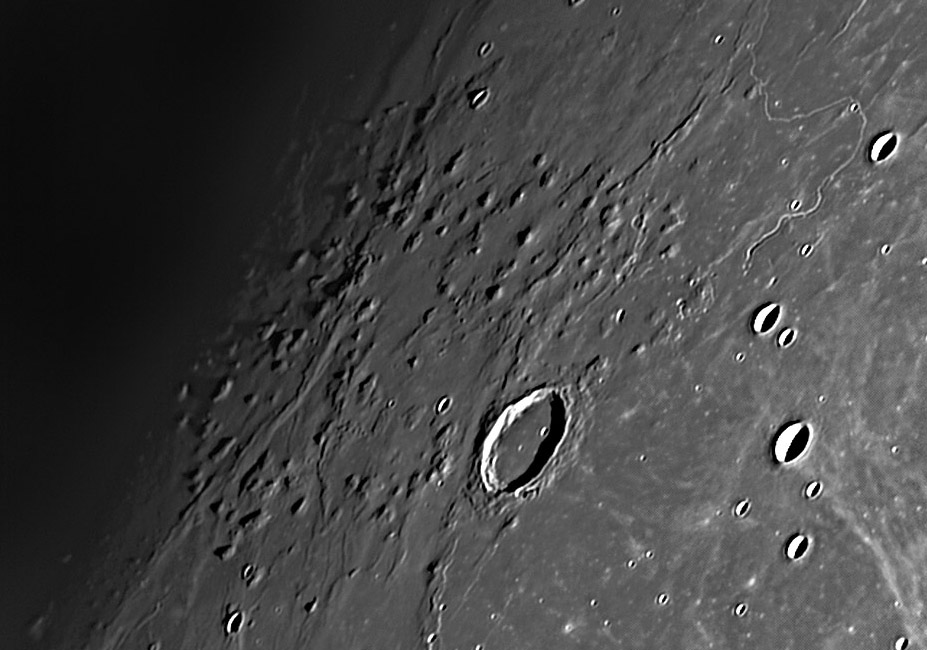Difference between revisions of "October 23, 2013"
| (One intermediate revision by the same user not shown) | |||
| Line 6: | Line 6: | ||
<em>image by [mailto:alf.vidal@ono.com Alfredo Vidal], L'Hospitalet del Llobregat / Barcelona (Catalonia/Spain)</em><br /> | <em>image by [mailto:alf.vidal@ono.com Alfredo Vidal], L'Hospitalet del Llobregat / Barcelona (Catalonia/Spain)</em><br /> | ||
<br /> | <br /> | ||
| − | On Earth, geologists have learned to at least partially understand why one type of volcano is located in a particular area and other types are in other regions. Plate tectonics is the major control because that strongly influences magma composition, gas content, volume and viscosity. The lack of plate tectonics now or ever on the Moon takes away that familiar key to understanding lunar volcanism. A case is point is the very familar occurrence of four different styles of volcanism in Oceanus Procellarum. [http://lpod. | + | On Earth, geologists have learned to at least partially understand why one type of volcano is located in a particular area and other types are in other regions. Plate tectonics is the major control because that strongly influences magma composition, gas content, volume and viscosity. The lack of plate tectonics now or ever on the Moon takes away that familiar key to understanding lunar volcanism. A case is point is the very familar occurrence of four different styles of volcanism in Oceanus Procellarum. [http://www2.lpod.org/wiki/February_19,_2009 Rümker] is a massive pile of volcanic domes, resulting from eruption of lavas that flowed relatively easily away from vents. The nearby [http://www2.lpod.org/wiki/August_5,_2008 Aristarchus Plateau] is veneered by pyroclastic deposits (ash) erupted from the [https://the-moon.us/wiki/Cobra_Head Cobra Head] volcanic mountain - these eruptions were explosively-driven by gases that don't seem to have been as abundant in other lunar magmas. Near the center of Procellarum are the Marius Hills, a tight grouping of a few hundred relatively steep-sided cones that probably formed from eruptions intermediate in gas content between Rümker and the Plateau pyroclastics. The volume of each eruption episode was relatively low because the cones are individually small. All three of these large volcanic complexes are surrounded by and embayed by mare lavas that were immensely more voluminous and apparently less viscous. And the Marius Hills shows us that magma conditions can change over time even at one location. Although most of the Hills are cones, there are some more gently-sided domes, rimless vents that were sources of rilles, and the massive and coarse lava flows on the north of the Hills. We can speculate, for example, that there must have been more or less gas available at different times to drive these different types of eruptions but we don't know why the gas content changed. Nor, on a larger scale, do we understand, even if all are [http://www2.lpod.org/wiki/January_28,_2011 mega-megadomes], why the three complexes are so different. See, there is plenty for young selenogists to do.<br /> |
<br /> | <br /> | ||
<em>[mailto:tychocrater@yahoo.com Chuck Wood]</em><br /> | <em>[mailto:tychocrater@yahoo.com Chuck Wood]</em><br /> | ||
| Line 14: | Line 14: | ||
<br /> | <br /> | ||
<strong>Related Links</strong><br /> | <strong>Related Links</strong><br /> | ||
| − | <em>[ | + | <em>[[21st Century Atlas of the Moon|21st Century Atlas]]</em> chart 22.<br /> |
<br /> | <br /> | ||
<p><b>Yesterday's LPOD:</b> [[October 22, 2013|Little Seen Rille]] </p> | <p><b>Yesterday's LPOD:</b> [[October 22, 2013|Little Seen Rille]] </p> | ||
Latest revision as of 08:35, 28 October 2018
Volcanic Drivers

image by Alfredo Vidal, L'Hospitalet del Llobregat / Barcelona (Catalonia/Spain)
On Earth, geologists have learned to at least partially understand why one type of volcano is located in a particular area and other types are in other regions. Plate tectonics is the major control because that strongly influences magma composition, gas content, volume and viscosity. The lack of plate tectonics now or ever on the Moon takes away that familiar key to understanding lunar volcanism. A case is point is the very familar occurrence of four different styles of volcanism in Oceanus Procellarum. Rümker is a massive pile of volcanic domes, resulting from eruption of lavas that flowed relatively easily away from vents. The nearby Aristarchus Plateau is veneered by pyroclastic deposits (ash) erupted from the Cobra Head volcanic mountain - these eruptions were explosively-driven by gases that don't seem to have been as abundant in other lunar magmas. Near the center of Procellarum are the Marius Hills, a tight grouping of a few hundred relatively steep-sided cones that probably formed from eruptions intermediate in gas content between Rümker and the Plateau pyroclastics. The volume of each eruption episode was relatively low because the cones are individually small. All three of these large volcanic complexes are surrounded by and embayed by mare lavas that were immensely more voluminous and apparently less viscous. And the Marius Hills shows us that magma conditions can change over time even at one location. Although most of the Hills are cones, there are some more gently-sided domes, rimless vents that were sources of rilles, and the massive and coarse lava flows on the north of the Hills. We can speculate, for example, that there must have been more or less gas available at different times to drive these different types of eruptions but we don't know why the gas content changed. Nor, on a larger scale, do we understand, even if all are mega-megadomes, why the three complexes are so different. See, there is plenty for young selenogists to do.
Chuck Wood
Technical Details
10/16/2013, 20:34:29 UT. Celestron C-11 Edge HD, f: 10, camera QHY5-LII, filter IR Pass, AS!2 and Registax 6.0. Good seeing
Related Links
21st Century Atlas chart 22.
Yesterday's LPOD: Little Seen Rille
Tomorrow's LPOD: More Volcano News
COMMENTS?
Register, Log in, and join in the comments.



